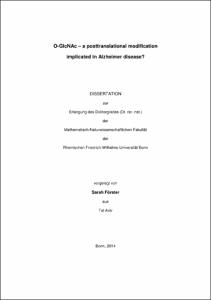Förster, Sarah: O-GlcNAc – a posttranslational modification implicated in Alzheimer disease?. - Bonn, 2015. - Dissertation, Rheinische Friedrich-Wilhelms-Universität Bonn.
Online-Ausgabe in bonndoc: https://nbn-resolving.org/urn:nbn:de:hbz:5n-39875
Online-Ausgabe in bonndoc: https://nbn-resolving.org/urn:nbn:de:hbz:5n-39875
@phdthesis{handle:20.500.11811/6452,
urn: https://nbn-resolving.org/urn:nbn:de:hbz:5n-39875,
author = {{Sarah Förster}},
title = {O-GlcNAc – a posttranslational modification implicated in Alzheimer disease?},
school = {Rheinische Friedrich-Wilhelms-Universität Bonn},
year = 2015,
month = apr,
note = {O-linked N-acetylglucosamine (O-GlcNAc) is a highly dynamic posttranslational modification which has been found on a myriad of nucleocytoplasmic proteins. O-GlcNAc addition and removal are catalyzed by two conserved enzymes, O-GlcNAc transferase (OGT) and O-GlcNAc hydrolase (OGA).
Alzheimer disease (AD) is one of the most common forms of dementia. The histopathological hallmarks of AD brain include neurofibrillary tangles of hyperphosphorylated tau and senile plaques consisting mainly of aggregated amyloid β-peptides which are generated from a larger transmembrane protein, the amyloid precursor protein (APP).
O-GlcNAc has been extensively studied in the context of AD. However, contradicting results have demonstrated either increased or decreased O-GlcNAcylation in AD brain. To date the underlying cause(s) as well as potential consequences of altered O-GlcNAcylation in AD are unknown. Both the microtubule-associated protein tau and APP are O-GlcNAc-modified. While some studies show that increased O-GlcNAcylation reduces tau hyperphosphorylation, the function of the O-GlcNAc modification of APP is not yet understood.
In this work, the potential involvement of O-GlcNAc in different aspects of AD pathology was investigated. For this purpose, a recently established in vitro OGT assay was used to demonstrate the O-GlcNAcylation of cyclin-dependent kinase 5 (cdk5), a kinase that phosphorylates both APP and tau and has been implicated in AD pathogenesis. The functional role of O-GlcNAcylation of cdk5 remains to be elucidated. Since OGT assays are useful tools for the analysis of OGT activity or for the identification of novel OGT targets, the established in vitro OGT assay was further refined using the nuclear pore protein Nup62 as a model substrate. To investigate the (potential) role of APP´s O-GlcNAcylation, effects of O-GlcNAc modulation on the proteolytic processing of APP were analyzed in cell culture studies. Increased O-GlcNAc expression by OGA inhibition did, however, not alter levels of the APP cleavage products sAPPα and sAPPβ. Furthermore, O-GlcNAc and, for the first time, O-GlcNAc cycling enzymes were investigated in brain samples of subjects with AD and amnestic mild cognitive impairment (MCI), a prodromal stage of AD. In AD brains, increased O-GlcNAcylation correlated with reduced OGA expression and activity while OGT expression was unaltered when compared with age-matched controls. In MCI brains, no changes in O-GlcNAc, OGA or OGT expression were observed.
Taken together this work suggests that O-GlcNAc may not play a direct role in APP processing and that altered O-GlcNAcylation may be a late event in the progression of AD. In combination with recent reports demonstrating positive effects of OGA inhibition in animal models of AD, it is obvious that further studies are needed to elucidate the role of O-GlcNAc in AD.},
url = {https://hdl.handle.net/20.500.11811/6452}
}
urn: https://nbn-resolving.org/urn:nbn:de:hbz:5n-39875,
author = {{Sarah Förster}},
title = {O-GlcNAc – a posttranslational modification implicated in Alzheimer disease?},
school = {Rheinische Friedrich-Wilhelms-Universität Bonn},
year = 2015,
month = apr,
note = {O-linked N-acetylglucosamine (O-GlcNAc) is a highly dynamic posttranslational modification which has been found on a myriad of nucleocytoplasmic proteins. O-GlcNAc addition and removal are catalyzed by two conserved enzymes, O-GlcNAc transferase (OGT) and O-GlcNAc hydrolase (OGA).
Alzheimer disease (AD) is one of the most common forms of dementia. The histopathological hallmarks of AD brain include neurofibrillary tangles of hyperphosphorylated tau and senile plaques consisting mainly of aggregated amyloid β-peptides which are generated from a larger transmembrane protein, the amyloid precursor protein (APP).
O-GlcNAc has been extensively studied in the context of AD. However, contradicting results have demonstrated either increased or decreased O-GlcNAcylation in AD brain. To date the underlying cause(s) as well as potential consequences of altered O-GlcNAcylation in AD are unknown. Both the microtubule-associated protein tau and APP are O-GlcNAc-modified. While some studies show that increased O-GlcNAcylation reduces tau hyperphosphorylation, the function of the O-GlcNAc modification of APP is not yet understood.
In this work, the potential involvement of O-GlcNAc in different aspects of AD pathology was investigated. For this purpose, a recently established in vitro OGT assay was used to demonstrate the O-GlcNAcylation of cyclin-dependent kinase 5 (cdk5), a kinase that phosphorylates both APP and tau and has been implicated in AD pathogenesis. The functional role of O-GlcNAcylation of cdk5 remains to be elucidated. Since OGT assays are useful tools for the analysis of OGT activity or for the identification of novel OGT targets, the established in vitro OGT assay was further refined using the nuclear pore protein Nup62 as a model substrate. To investigate the (potential) role of APP´s O-GlcNAcylation, effects of O-GlcNAc modulation on the proteolytic processing of APP were analyzed in cell culture studies. Increased O-GlcNAc expression by OGA inhibition did, however, not alter levels of the APP cleavage products sAPPα and sAPPβ. Furthermore, O-GlcNAc and, for the first time, O-GlcNAc cycling enzymes were investigated in brain samples of subjects with AD and amnestic mild cognitive impairment (MCI), a prodromal stage of AD. In AD brains, increased O-GlcNAcylation correlated with reduced OGA expression and activity while OGT expression was unaltered when compared with age-matched controls. In MCI brains, no changes in O-GlcNAc, OGA or OGT expression were observed.
Taken together this work suggests that O-GlcNAc may not play a direct role in APP processing and that altered O-GlcNAcylation may be a late event in the progression of AD. In combination with recent reports demonstrating positive effects of OGA inhibition in animal models of AD, it is obvious that further studies are needed to elucidate the role of O-GlcNAc in AD.},
url = {https://hdl.handle.net/20.500.11811/6452}
}






